 Source: DTN News / Boeing
Source: DTN News / Boeing(NSI News Source Info) RAAF BASE WILLIAMTOWN, New South Wales,- May 7, 2010: The Boeing Company [NYSE: BA] May 5., announced that the Commonwealth of Australia has accepted the first two Project Wedgetail 737 Airborne Early
 Warning and Control (AEW&C) aircraft into the Royal Australian Air Force (RAAF) fleet.
Warning and Control (AEW&C) aircraft into the Royal Australian Air Force (RAAF) fleet.The aircraft were accepted during a ceremony today at RAAF Base Williamtown, the main operating base for the Wedgetail fleet.
"This major milestone demonstrates that the 737 AEW&C system is ready for operational training and use. It also represents the culmination of years of design, development, modification and testing by the Boeing-led team to bring this complex system -- the first of its type -- to our first AEW&C customer," said Maureen Dougherty, Boeing vice president, AEW&C Program.
Acceptance of the two Wedgetail aircraft means ground and flight operations and maintenance of the aircraft are now fully under RAAF control. Boeing delivered the two aircraft last year and has been supporting RAAF familiarization training on the AEW&C system, which includes the aircraft as well as the Operational Flight Trainer, Operational Mission Simulator and Mission Support System.
Boeing will deliver three more Wedgetail aircraft to the RAAF by the end of this year, including one upgraded in the final AEW&C configuration with Electronic Support Measures. All aircraft in the Wedgetail fleet will be upgraded to the final configuration in early 2011.
Project Wedgetail includes six 737 AEW&C aircraft, plus ground support segments for mission crew training, mission support and system maintenance. Based on the Boeing Next-Generation 737-700 commercial airplane, the 737 AEW&C aircraft is designed to provide airborne battle-management capability with an advanced multirole electronically scanned radar and 10 state-of-the-art mission crew consoles that are able to track airborne and maritime targets simultaneously. The mission crew can direct offensive and defensive forces while maintaining continuous surveillance of the operational area.
Boeing also has AEW&C systems in production for Turkey and the Republic of Korea.
A unit of The Boeing Company, Boeing Defense, Space & Security is one of the world’s largest defense, space and security businesses specializing in innovative and capabilities-driven customer solutions, and the world’s largest and most versatile manufacturer of military aircraft. Headquartered in St. Louis, Boeing Defense, Space & Security is a $34 billion business with 68,000 employees worldwide.
The initial contract was for four AEW&C systems with options for up to three additional systems. The contract also provides a mission support segment and the associated ground based support segments for flight and mission crew training. In May 2004, Australia exercised options to purchase an additional two aircraft.
Boeing Australia is responsible for providing systems engineering and leading the product support teams. BAE Systems Australia is to supply the electronic support measures and the electronic warfare self-protection systems. Quantas Airways has been awarded the contract for maintenance of the aircraft. The first two aircraft will be completed by Boeing in the USA; the remainder will be modified in Australia.
The first airframe for modification was rolled out in December 2002, ready for modification and installation of the radar and systems. First flight of the aircraft with the radar and mission systems took place at the Boeing Field in Seattle in May 2004. Performance and flight handling tests were completed in July 2005. The first aircraft for modification in Australia arrived in January 2006.
Delivery of the first two aircraft, capable of peacekeeping and training roles to the Australian Air Force is planned for July 2009. These aircraft will then be upgraded to full mission capable status by January 2010. The remaining four aircraft will be delivered, fully mission capable, in early 2010. It is expected that the first aircraft will enter service with the Royal Australian Air Force's new Number 2 Squadron, with headquarters at Williamstown Air Base, by the end of 2010.
In May 2002, the Turkish government signed a contract with Boeing for four 737 AEW&C systems with options on a further two. The sale received US Government approval in September 2003. Boeing is modifying the first and Tusas Aerospace Industries (TAI) of Ankara the other three. The first aircraft for local modification arrived in March 2006.
Deliveries of the system, to be known as Peace Eagle, are expected by 2010. The first flight of the Peace Eagle was in September 2007. The first aircraft modified by TAI flew in July 2008.
In August 2006, the 737 AEW&C was selected as 'sole candidate' for South Korea's E-X requirement for four surveillance aircraft to be delivered by 2012. The contract was awarded to Boeing in November 2006.


















No comments:
Post a Comment